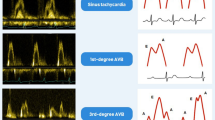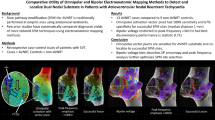Abstract
This study aimed to investigate the electromechanical function detected by acoustic cardiography before and after radiofrequency ablation therapy (RFA) in paroxysmal AF (PAF) patients with preserved left ventricular ejection fraction (LVEF). Seventy-five symptomatic PAF patients and 69 patients without arrhythmia were enrolled. Thirty-seven PAF patients received RFA therapy. Acoustic cardiographic exam was performed to check S3 and S4 heart sound, electromechanical activation time (EMAT), LV systolic time percentage (LVST), and systolic dysfunction index (SDI) in all participants. Furthermore, 37 PAF patients also received follow-up acoustic cardiography postRFA. PAF had impaired electromechanical systolic function compared with health participants (%EMAT 14.69 ± 3.62 vs. 10.84 ± 2.62; %LVST 40.83 ± 5.14 vs. 36.70 ± 3.87; SDI 4.75 ± 1.61 vs. 3.26 ± 0.96 all p < 0.001). RFA can improve electromechanical systolic function. Improvement below 13.1% could predict the recurrent AF postcatheter ablation. Higher degree of improved electromechanical systolic function postRFA contribute to lower recurrence of AF.

Receiver operating characteristic (ROC) curve analysis for % change of systolic dysfunction index (SDI) postRFA in the detection of recurrent AF

Similar content being viewed by others
References
January, C. T., Wann, L. S., Alpert, J. S., Calkins, H., Cigarroa, J. E., Cleveland Jr., J. C., et al. (2014). 2014 AHA/ACC/HRS guideline for the management of patients with atrial fibrillation: a report of the American College of Cardiology/American Heart Association task force on practice guidelines and the Heart Rhythm Society. Journal of the American College of Cardiology, 21, e1–e76.
Clark, D. M., Plumb, V. J., Epstein, A. E., & Kay, G. N. (1997). Hemodynamic effects of an irregular sequence of ventricular cycle lengths during atrial fibrillation. Journal of the American College of Cardiology, 30, 1039–1045.
Chen, S. A., Hsieh, M. H., Tai, C. T., Tsai, C. F., Prakash, V. S., Yu, W. C., et al. (1999). Initiation of atrial fibrillation by ectopic beats originating from the pulmonary veins: electrophysiological characteristics, pharmacological responses, and effects of radiofrequency ablation. Circulation., 100, 1879–1886.
Gentlesk, P. J., Sauer, W. H., Gerstenfeld, E. P., Lin, D., Dixit, S., Zado, E., et al. (2007). Reversal of left ventricular dysfunction following ablation of atrial fibrillation. Journal of Cardiovascular Electrophysiology, 18, 9–14.
Sanders, P., Morton, J. B., Davidson, N. C., Spence, S. J., Vohra, J. K., Sparks, P. B., et al. (2003). Electrical remodeling of the atria in congestive heart failure: electrophysiological and electroanatomic mapping in humans. Circulation., 108, 1461–1468.
Hunter, R. J., Liu, Y., Lu, Y., Wang, W., & Schilling, R. J. (2012). Left atrial wall stress distribution and its relationship to electrophysiologic remodeling in persistent atrial fibrillation. Circulation. Arrhythmia and Electrophysiology, 5, 351–360.
Moyers, B., Shapiro, M., Marcus, G. M., Gerber, I. L., McKeown, B. H., Vessey, J. C., et al. (2007). Performance of phonoelectrocardiographic left ventricular systolic time intervals and B-type natriuretic peptide levels in the diagnosis of left ventricular dysfunction. Annals of Noninvasive Electrocardiology, 12, 89–97.
Roos, M., Toggweiler, S., Jamshidi, P., Zuber, M., Kobza, R., Meier, R., et al. (2008). Noninvasive detection of left ventricular systolic dysfunction by acoustic cardiography in cardiac failure patients. Journal of Cardiac Failure, 14, 310–319.
Shapiro, M., Moyers, B., Marcus, G. M., Gerber, I. L., McKeown, Vessey, J. C., et al. (2007). Diagnostic characteristics of combining phonocardiographic third heart sound and systolic time intervals for the prediction of left ventricular dysfunction. Journal of Cardiac Failure, 13, 18–24.
Roos, M., Toggweiler, S., Zuber, M., Jamshidi, P., & Erne, P. (2006). Acoustic cardiographic parameters and their relationship to invasive hemodynamic measurements in patients with left ventricular systolic dysfunction. Congestive Heart Failure, 12(Suppl 1), 19–24.
Walia, R., Chang, S. L., Lin, Y. J., Lo, L. W., Hu, Y. F., Chao, T. F., et al. (2019). Early detection of electromechanical dysfunction in patients with idiopathic premature ventricular contractions. Pacing and Clinical Electrophysiology, 42, 637–645.
Dillier, R., Kobza, R., Erne, S., Zuber, M., Arand, P., & Erne, P. (2011). Noninvasive detection of left-ventricular systolic dysfunction by acoustic cardiography in atrial fibrillation. Cardiology Research and Practice., 2010, 1–7.
Kosmicki, D. L., Collins, S. P., Kontos, M. C., Zuber, M., Kipfer, P., & Attenhofer, J. C. (2010). Noninvasive prediction of left ventricular systolic dysfunction in patients with clinically suspected heart failure using acoustic cardiography. Congestive Heart Failure, 16, 249–253.
Collins, S. P., Kontos, M. C., Michaels, A. D., Zuber, M., Kipfer, P., Jost, C. A., et al. (2010). Utility of a bedside acoustic cardiographic model to predict elevated left ventricular filling pressure. Emergency Medicine Journal: EMJ., 27, 667–682.
Wang, S., Fang, F., Liu, M., Lam, Y. Y., Wang, J., Shang, Q., et al. (2013). Rapid bedside identification of high-risk population in heart failure with reduced ejection fraction by acoustic cardiography. International Journal of Cardiology, 168, 1881–1886.
Lo, L. W., Tai, C. T., Lin, Y. J., Chang, S. L., Wongcharoen, W., Chang, S. H., et al. (2007). Progressive remodeling of the atrial substrate-a novel finding from consecutive voltage mapping in patients with recurrence of atrial fibrillation after catheter ablation. Journal of Cardiovascular Electrophysiology, 18, 258–265.
Chang, S. L., Tai, C. T., Lin, Y. J., Wongcharoen, W., Lo, L. W., Tuan, T. C., et al. (2007). The efficacy of inducibility and circumferential ablation with pulmonary vein isolation in patients with paroxysmal atrial fibrillation. Journal of Cardiovascular Electrophysiology, 18, 607–611.
Linderer, T., Chatterjee, K., Parmley, W. W., Sievers, R. E., Glantz, S. A., & Tyberg, J. V. (1983). In uence of atrial systole on the Frank-Starling relation and the end-diastolic pressure-diameter relation of the left ventricle. Circulation., 67, 1045–1053.
Friberg, L., Hammar, N., Edvardsson, N., & Rosenqvist, M. (2009). The prognosis of patients with atrial brillation is improved when sinus rhythm is restored: report from the Stockholm cohort of atrial fibrillation (SCAF). Heart., 95, 1000–1005.
Jones, D. G., Haldar, S. K., Hussain, W., Sharma, R., Francis, D. P., Rahman-Haley, S. L., et al. (2013). A randomized trial to assess catheter ablation versus rate control in the management of persistent atrial fibrillation in heart failure. Journal of the American College of Cardiology, 61, 1894–1903.
Hunter, R. J., Berriman, T. J., Diab, I., Kamdar, R., Richmond, L., Baker, V., et al. (2014). A randomized controlled trial of catheter ablation versus medical treatment of atrial fibrillation in heart failure (the CAMTAF trial). Circulation. Arrhythmia and Electrophysiology, 7, 31–38.
January, C. T., Wann, L. S., Alpert, J. S., Calkins, H., Cigarroa, J. E., Cleveland Jr., J. C., et al. (2014). 2014 AHA/ACC/HRS guideline for the management of patients with atrial fibrillation: a report of the American College of Cardiology/American Heart Association task force on practice guidelines and the Heart Rhythm Society. Journal of the American College of Cardiology, 64, 2305–2307.
Packer, D. L., Mark, D. B., Robb, R. A., Monahan, K. H., Bahnson, T. D., Poole, J. E., et al. (2019). Effect of catheter ablation vs antiarrhythmic drug therapy on mortality, stroke, bleeding, and cardiac arrest among patients with atrial fibrillation: the CABANA randomized clinical trial. JAMA., 321, 1261–1274.
Authorship
All authors contributed to the study conception and design. Material preparation and data collection were performed by Kuo-Li Pan, Yenn-Jiang Lin, Li-Wei Lo, Yu-Feng Hu, Fa-Po Chung, Tze-Fan Chao, Jo-Nan Liao, Chin-Yu Lin, Chung-Hsing Lin, Abigail Louise D. Te, Shinya Yamada, and Yao-Ting Chang. The data analysis was performed by Kuo-Li Pan and Shih-Lin Chang. The first draft of the manuscript was written by Kuo-Li Pan. This study was supervised by Shih-Ann Chen. And all authors commented on previous versions of the manuscript. All authors read and approved the final manuscript.
Author information
Authors and Affiliations
Corresponding author
Ethics declarations
This study was approved by the Taipei Veterans General Hospital Institutional Review Board (IRB no: 2014-09-012A), and informed consents were obtained from healthy individuals and all symptomatic consecutive PAF patients who participated this study.
Ethical Approval
All procedures performed in studies involving human participants were in accordance with the ethical standards of the institutional and national research committee and with the 1964 Helsinki Declaration and its later amendments or comparable ethical standards.
Conflict of Interest
The authors declare that they have no conflict of interest.
Additional information
Associate Editor Sunil Kapur oversaw the review of this article
Publisher’s Note
Springer Nature remains neutral with regard to jurisdictional claims in published maps and institutional affiliations.
Highlights
• Symptomatic paroxysmal atrial fibrillation patients had impaired electromechanical systolic function
• Higher degree of improved electromechanical systolic function postradiofrequency ablation of paroxysmal atrial fibrillation contributed to lower recurrence of atrial fibrillation.
Rights and permissions
About this article
Cite this article
Pan, KL., Chang, SL., Lin, YJ. et al. Left Ventricular Electromechanical Remodeling Detected by Acoustic Cardiography in Paroxysmal Atrial Fibrillation. J. of Cardiovasc. Trans. Res. 14, 348–354 (2021). https://doi.org/10.1007/s12265-020-10047-y
Received:
Accepted:
Published:
Issue Date:
DOI: https://doi.org/10.1007/s12265-020-10047-y




